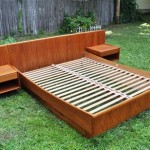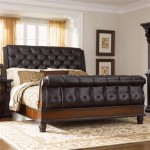What Is The Best Wood To Use For A Bed Frame?
Choosing the right wood for a bed frame is an important decision that will impact the durability, aesthetics, and overall lifespan of your furniture. With so many wood species available, it can be overwhelming to determine which one is best suited for your needs. This article will explore the factors to consider when selecting wood for a bed frame, highlighting the advantages and disadvantages of popular choices.
Durability and Strength
The primary function of a bed frame is to provide a sturdy and stable support for your mattress and body. Therefore, choosing a durable and strong wood species is crucial. Hardwoods generally excel in these qualities due to their dense and tightly-grained structure. Some of the most durable wood options for bed frames include:
- Oak: Known for its strength, durability, and resistance to scratches and dents. It is also a popular choice for its classic and elegant appearance.
- Maple: Offers exceptional strength and hardness, making it an excellent choice for high-traffic areas and heavy use.
- Cherry: Although slightly softer than oak or maple, cherry wood is still considered durable and holds up well over time. It is prized for its warm reddish-brown tones and beautiful grain pattern.
- Walnut: Known for its rich, dark brown color and beautiful grain patterns, walnut wood is also strong and durable.
While hardwoods are generally more durable, some softwoods can also be suitable for bed frames. Pine, for example, is lightweight and affordable, making it a popular option for budget-conscious buyers. However, pine is softer than hardwoods and may be more susceptible to scratches and dents. It is important to choose high-quality, kiln-dried pine for a bed frame to ensure its durability and longevity.
Aesthetics and Style
The appearance of your bed frame will play a significant role in the overall aesthetic of your bedroom. Wood species offer a wide range of colors, grain patterns, and textures to complement any décor.
- Oak: Known for its classic and elegant appearance, oak wood adds a touch of sophistication to any bedroom. It can be finished in various colors and stains, offering versatility in matching your existing décor.
- Maple: Provides a clean and contemporary look due to its light color and tight grain. It is often used in modern and minimalist bedroom settings.
- Cherry: Renowned for its warm reddish-brown tones and beautiful grain patterns, cherry wood adds a touch of warmth and sophistication to a bedroom.
- Walnut: Offers a rich, dark brown color and striking grain patterns, creating a luxurious and elegant ambiance.
- Pine: Provides a rustic and natural feel with its warm, yellowish-brown color and knots. It is a popular choice for farmhouse and cottage-style bedrooms.
Cost and Availability
Wood species vary significantly in terms of cost and availability. Hardwoods are generally more expensive than softwoods. Some wood species, such as oak, maple, and cherry, may be more readily available than others, such as walnut, which can be scarce and therefore pricier.
When considering cost, it is essential to factor in not only the price of the wood itself but also the labor costs for building the bed frame. If you plan to construct the bed frame yourself, choose a wood that is easy to work with and requires minimal specialized tools. However, if you are hiring a professional carpenter, you may need to choose a more readily available and affordable wood to keep the overall cost down.
Maintenance and Care
Different wood species require varying degrees of maintenance and care. Hardwoods are generally more resistant to scratches and dents and require less frequent refinishing than softwoods.
- Oak: Durable and resistant to scratches and dents, oak wood requires regular cleaning and dust removal. It can be refinished easily to restore its original appearance.
- Maple: Relatively resistant to scratches and dents, maple wood benefits from regular dust removal and occasional cleaning with a damp cloth.
- Cherry: Susceptible to scratches and dents, cherry wood requires careful handling. It benefits from regular cleaning and dusting and occasional refinishing to maintain its beauty.
- Walnut: Known for its rich, dark color, walnut wood requires regular dust removal and occasional cleaning with a damp cloth. It can be easily refinished to restore its color and shine.
- Pine: Being a softer wood, pine is more susceptible to scratches and dents. It may require more frequent refinishing than hardwoods to maintain its appearance.
To prolong the life of your bed frame, it is important to choose a wood that is suitable for the environment in which it will be placed. Avoid using wood in areas with high humidity, as it can warp and crack.

Best Wood For Bed Frames Balance Form And Function

Best Wood For Bed Frame 13 Most Popular Soft And Hardwoods

Best Wood For Bed Frame 13 Most Popular Soft And Hardwoods

7 Reasons Wooden Bed Frames Are The Best Choice For Your Knock On Wood Furniture Gallery

Bed Slats Vs Plywood Which Is Best For Your Frame

The Best Wood For Bed Frame By A Lumber Pro Nov 2024

The 10 Best Modern Bed Frames Of 2024 Reviews By Wirecutter

Best Wood For Bed Frame 13 Most Popular Soft And Hardwoods

The 10 Best Modern Bed Frames Of 2024 Reviews By Wirecutter

7 Sustainable Wooden Bed Frames The Good Trade







